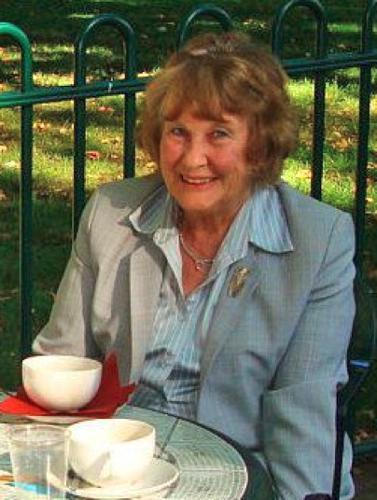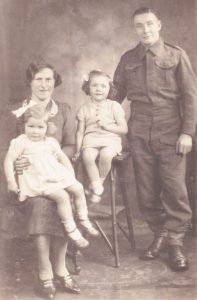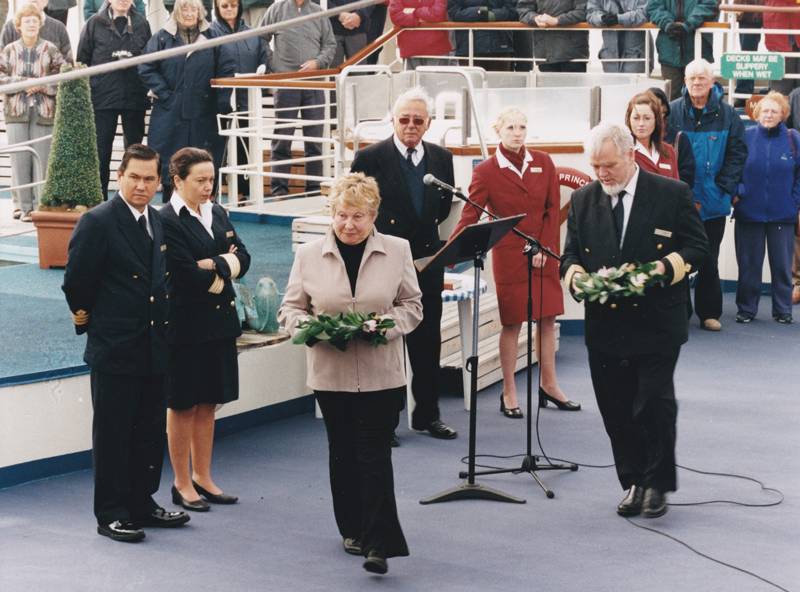“The Pilgrimage”
 Catherine Iris P L Loveday (pictured), hardly knew her father, she was a very small child at the outbreak of the Second World War when he joined the Army. He was posted to the 3rd Maritime Royal Artillery as a gunner on the Norwegian tanker MV John Pedersen which sailed from Halifax, Nova Scotia in Canada bound for The Clyde, Scotland. He died at sea in May 1941 when his ship was torpedoed and sunk by a German U-boat 160 miles south of Greenland.
Catherine Iris P L Loveday (pictured), hardly knew her father, she was a very small child at the outbreak of the Second World War when he joined the Army. He was posted to the 3rd Maritime Royal Artillery as a gunner on the Norwegian tanker MV John Pedersen which sailed from Halifax, Nova Scotia in Canada bound for The Clyde, Scotland. He died at sea in May 1941 when his ship was torpedoed and sunk by a German U-boat 160 miles south of Greenland.
He is remembered on the Chatham Naval memorial in Kent and on the war memorial in East Barnet.
Many years after he died Catherine set out with her husband George to retrace her father’s last journey. The pilgrimage was in two parts with a break of five years. This is her story.
We arrived in Halifax, Nova Scotia in Canada on Monday 23 August 1999, having taken the ferry from Maine in the USA to Yarmouth in Nova Scotia and driven two hundred miles on an almost deserted road. The countryside was green and fertile and very reminiscent of the English countryside except for the lack of towns and villages.
The sea trip was very eventful; we were entertained to a wonderful display by humpbacked whales breaching and porpoises and dolphins engaged in synchronized swimming. We crossed the McDonald suspension bridge, which spans the harbour from Halifax to Dartmouth and is the second longest suspension bridge in the British Commonwealth.
During the Second World War, from 1940 the North Atlantic Convoys amassed in the Bedford Basin of Halifax Harbour, it being one of the largest natural harbours in the northern hemisphere and so was the ideal venue for the gathering together of ships of all types to form the Halifax Convoys. The convoys were so essential for the well-being of the British people, this was their life line, the convoys were transporting essential foodstuffs and fuel to our isolated island.
We walked along the wooden broadwalk of the splendid harbour passed the naval dockyards where many navy ships were docked, some being repaired in dry dock. The atmosphere was one of peace and tranquility, the sun shone and sparkled on the still water, how different to how I imagined it would have been in 1941 when my Father was there; there would have been such a bustle of activities, so many sailors and soldiers dashing around, no time to stop and enjoy the taste of sea on their lips, to smell the fishiness in the air and feel the light breeze in their hair.
My Father, Stanley F Chapman, arrived in Halifax aboard the troop ship Georgic in April 1941 as a soldier in the Oxfordshire and Buckinghamshire Regiment (Ox & Bucks). He was barracked at Camp Debert, a military base which is in Truro 65 miles north of Halifax. During his three weeks there he wrote of the generosity of the Canadian people and of their kindness and how, when the war was over, he would like to go back there and take my mother and his angels (my sister and I) for a holiday.
That was over 58 years ago and now I have been there and walked along the ancient wooden planks where he embarked on the Halifax 126 Convoy from Pier 21 on May 10 1941, four days after his transfer into the new regiment of the 3rd Maritime Royal Artillery. In fact, my father is quite unique is as much as he has two death certificates, one with his regiment as the Ox & Bucks and the other recording him as being in the Maritime Royal Artillery. Such were the pressures of wartime, there was no time to keep accurate records.
I have looked across the harbour at Dartmouth where he once looked and out to sea past St George’s Island with its lighthouse, these would have been the last views he ever had of land. We visited the Museum on the sea front – it was very informative – we learnt of the typical meal served on the war time ships. It was called “red lead and cap tallies” and consisted of tinned tomatoes and streaky bacon. The convoys were a motley assortment of ships, all types and sizes with a corvette placed each side and the oil tankers were at the centre, inside the other ships to give maximum protection. There was an area of air cover over a radius from Halifax to a point SW of Greenland – then there was no air protection and ships in this area known as “The Black Pit” had only the brave men of the Maritime Royal Artillery gunners and the defensively equipped merchant ships (DEMS) equipped with their Lewis guns to protect their valuable cargo from the enemy.
On enquiring about Camp Debert, we were surprised to learn that a small part of it still existed and we drove to Truro, not knowing quite what we were looking for or what we would find. Most of the site was now a large industrial centre, but we found some military huts that had remained and two of these huts were now being converted into a museum by some very enthusiastic students. It was amazing to find their existence after all these years – here I was on August 24th, 1999 – my son’s 34th birthday – standing near the spot where my father would have spent his 28th and last birthday in April 1941.
The huts were built in the shape of an H; one arm housed the officers with a single room each and the other arm accommodated the men who shared 4 to a room, but the rooms were airy, well lit and spacious. The bar joining the two arms contained bathrooms. There was a large outdoor recreation area, containing an ice rink and a pitch for football and hockey. Very luxurious compared to the very cramped conditions on a tanker. I felt I needed to take something tangible from the camp and was fortunate enough to obtain a large, sketch- plan of the comp as it was originally built – George was not very keen, because of its size and voiced his apprehension at fitting it into the suitcase, even though it was rolled up – but I managed to persuade him!
At Cap Breton we overlooked the Sydney Basin and Harbour, it was here that small convoys were formed or additional ships were prepared and later joined up with the Halifax convoys. By this time we have followed our pilgrimage as far as we could.
The ill fated Halifax 126 Convoy encountered U boats when it was SW of Cape Farewell off Greenland on May 20 1941 – they were obviously preparing a route for the German Battleship “Bismarck” which was approaching that area. The ships were now in “The Black Pit” and the order was given ‘to scatter’ as the ships peeled off the tankers were now completely exposed to the enemy. My Father was a gunner on the MV John Pedersen which was carrying crude oil, a Norwegian Tanker requisitioned for the British Navy, there were 38 crew men in all, most of the Norwegians but there were four British gunners.
When the first torpedo hit the John Pedersen it went up in flames, two life boats were launched, one containing 21 men, which was subsequently picked up and all the men safely transferred to Reykjavik – the second boat contained 16 men – alas these men were never picked up but were left to their own resources. The last member of the crew, my Father, jumped from the burning ship into the sea, when his body was pulled into one of the boats it was apparent that he had swallowed too much oil.
I was able to continue my pilgrimage five years later, in August 2004, when we were cruising in the Arctic Circle, aboard the MV Black Prince of the Fred Olsen Line, through the fjords of Greenland, sailing through avenues of blue icebergs hundreds of metres high as we travelled through the Arctic Ocean, through sea ice.
A week into our cruise we were advised that due to bad weather and ice conditions our route for the next day would have to be modified and the ship would now be sailing around Cape Farewell to the south of Greenland, close to the spot where my father’s ship had been sunk.
A day or so earlier, I had spoken to the Norwegian Captain, Jan Thommessen about the fate of the MV John Pedersen during the war. The Cruise director, John Butt was also aware of my interest in sailing past Cape Farewell.
The Captain approached me and informed me that early the next day, the ship would be stopped at the exact spot where the ship went down (he had been able to ascertain the nautical position by contacting Norway by satellite ‘phone) and that he would hold a Memorial Service and a laying of wreaths on the sea to the memory of all those seamen who perished during the war and have only the sea for their graves.
He said that he would mention my father’s name and ship and the date of his death and asked me if I wished to take an active part in the service.
On 17th August, we woke to a bright morning with blue sky and just before 8.30am the sun came out as we anchored just off Cape Farewell, with the beautiful shoreline with its jagged coastline and imposing glaciers and ice cap was just visible on the horizon. Almost all of the 400 guests on board were now assembled on the deck with the Captain and members of the crew for the Service. The Captain addressed us and the Cruise Director gave the Remembrance Prayer; this was followed by a magnificent rendering of The Last Post by the ship’s trumpeter, Leo Shavers, then there was a two minute silence before Reveille.
Catherine at a service commemorating the sinking of the Norwegian ship John Pedersen which was torpedoed on 20/5/41. Catherine’s father served on the ship and ensured that all hands were in the lifeboats whilst he manned the Lewis gun until he went down with his ship. Catherine is holding a wreath as is Cpt Jan George Thommessen. The service was held 20 nautical miles off Cape Farewell on 17/8/2004.
The Captain then dedicated a wreath on behalf of seamen everywhere who had lost at sea and invited me to cast a wreath in memory of my father who had perished at this exact spot sixty-three years earlier.
I walked across the deck towards the Captain and the Cruise Director handed me a wreath, then together, the Captain and I walked to the starboard side of the ship and cast our wreaths onto a calm and peaceful sea. The sun shone on the wreaths and a flock of gulls appeared and settled on the waves. A wonderful rendering of Nimrod was played before the Captain walked back to his position with his crew and declared the Service over.
I remained by the rail of the ship looking out to sea, transfixed by the very moving and emotional Memorial Service to my Father; after over 63 years he had now had a dedicated memorial service and, for me, it was as though this was his burial service and perhaps I could now find closure. Whilst I remained there watching the wreath drift further away, the Captain came back to comfort me, followed by the Cruise Director and gradually one by one most of the people on the boat came and offered their condolences. Many of whom I had not met or spoken to previously.
During the rest of that day and during the days until the end of the voyage, I was approached by many people who told me they found the whole service such a truly emotionally and unforgettable event and how much moved they were by it; so simply conducted but very genuine and how most were moved to tears.
This moving and emotional service will stay with me forever.
Catherine Loveday
August 2004


